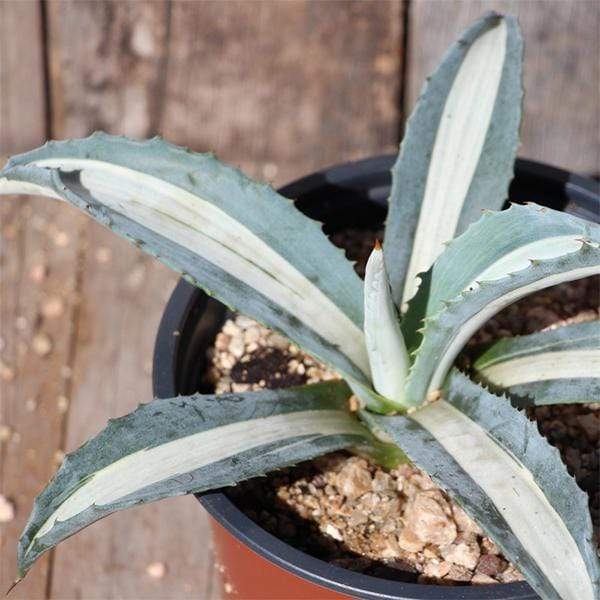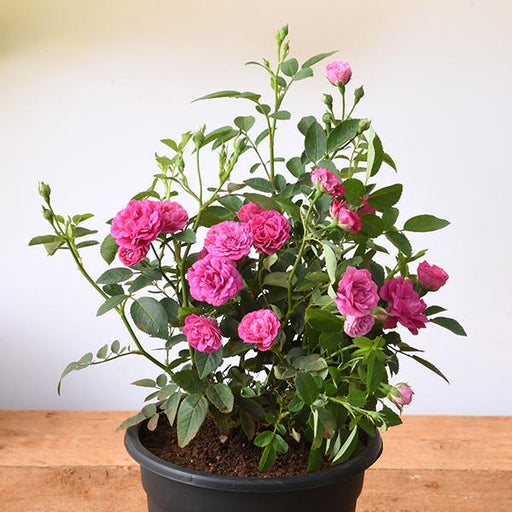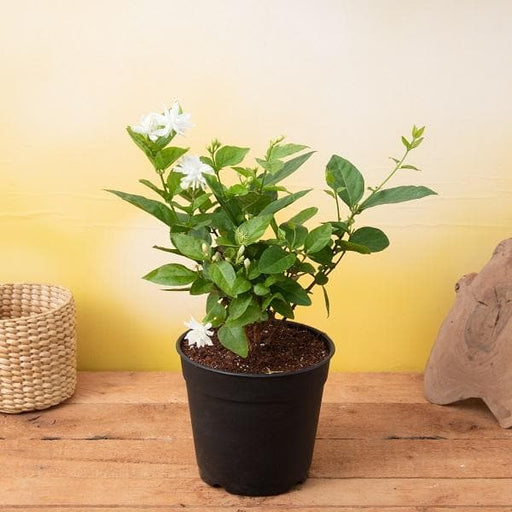
Agave americana - Succulent Plant
(MRP Inclusive of all taxes)
- Shipping ₹79 for entire order
- Dispatch in 7 days
- Country of origin: India

(MRP Inclusive of all taxes)
 Save 29%
Save 29%
Air Purifier Money Plant with Pot The Air Purifier Money Plant, also known as Pothos or Epipremnum aureum, is a stunning indoor plant that...
View full details
 Save up to 15%
Save up to 15%
Peace Lily, Spathiphyllum - Plant The Peace Lily, scientifically known as Spathiphyllum, is a stunning houseplant celebrated for its elegant white...
View full details
 Save 25%
Save 25%
Jasminum sambac, Mogra, Arabian Jasmine - Plant Jasminum sambac, commonly known as Mogra or Arabian Jasmine, is a fragrant flowering plant...
View full details
 Save 18%
Save 18%
Combo Constituents Includes the Parijat Tree (Night-Flowering Jasmine), a culturally significant plant with fragrant flowers. Description The Pari...
View full details
 Save 25%
Save 25%
Miniature Rose, Button Rose (Any Color) - Plant The Miniature Rose, also known as the Button Rose, is a charming and compact flowering plant that ...
View full details Save 25%
Save 25%
Damascus Rose, Scented Rose (Any Color) - Plant The Damascus Rose, also known as Rosa damascena, is a timeless symbol of beauty and romanc...
View full details
 Save 17%
Save 17%
Beautiful Fragrant Mogra, Arabian Jasmine Plant with Pot The Beautiful Fragrant Mogra, also known as Arabian Jasmine (Jasminum sambac), is...
View full details Save 15%
Save 15%
Pack of Vermicompost and Neem Cake for House Plants Transform your indoor garden with our premium Pack of Vermicompost and Neem Cake, spec...
View full details
Pack of Plant Growth and Flower Boosters Unlock the full potential of your garden with our Pack of Plant Growth and Flower Boosters! This ...
View full details Save 38%
Save 38%
Combo of Jeevamrut and Neem Raksha for Easy Growth and Protection of Houseplants Transform your indoor garden with our exclusive combo of ...
View full details Save 22%
Save 22%
Plant Nutrients Kit (Pack of 16) for a Healthy Garden Transform your garden into a lush paradise with our Plant Nutrients Kit, featuring 1...
View full details Save 16%
Save 16%
Combo of Top Plant Fertilizers Elevate your gardening game with our exclusive Combo of Top Plant Fertilizers, featuring two bags of premiu...
View full details Save 24%
Save 24%
Pack of 4 Additives to Make Soil Healthy and Nutrient Rich Transform your garden into a thriving ecosystem with our Pack of 4 Additives de...
View full details Save 30%
Save 30%
Transform your gardening experience with our premium Combo of Perlite and Vermiculite. This unique blend is designed to enhance soil aeration and ...
View full details Save 27%
Save 27%
Combo of 2 Vermicompost and Cocopeat - Enrich Your Soil Naturally! Transform your garden into a thriving ecosystem with our Combo of 2 Ver...
View full details
 Save 35%
Save 35%
Best 6 Plants for Perfect Indoor Garden Transform your living space into a lush oasis with our curated collection of the Best 6 Plants for a...
View full details
 Save up to 50%
Save up to 50%
Mini Succulent Garden Pack Transform your space with our Mini Succulent Garden Pack, featuring a delightful collection of 4 any variety beautiful s...
View full details
 Save 30%
Save 30%
5 Best Fragrant Plants Transform your garden or indoor space into a fragrant paradise with our curated selection of the 5 Best Fragrant Plants. Th...
View full details
 Save 24%
Save 24%
Set of 2 Bonsai Looking Grafted Adeniums Transform your indoor or outdoor space with our exquisite Set of 2 Bonsai Looking Grafted Adenium...
View full details Save 45%
Save 45%
Top 4 Die Hard Succulents Pack Transform your indoor or outdoor space with our Top 4 Die Hard Succulents Pack, featuring a curated selecti...
View full details
 Save 30%
Save 30%
5 Best Indoor Plants Pack Transform your living space into a lush oasis with our '5 Best Indoor Plants Pack.' This carefully curated collection fe...
View full details
 Save 25%
Save 25%
Set of 4 Evergreen Air Purifier Plant Pack Transform your indoor space into a lush, green oasis with our Set of 4 Evergreen Air Purifier Pla...
View full details| SrNo | Item Name | Qty |
|---|---|---|
| 1 | Agave americana Succulent Plant in 3 inch (8cm) Pot | 1 |
Agave americana, commonly known as the Century Plant, is a striking succulent native to the arid regions of Mexico and the southwestern United States. This hardy plant features long, spiky leaves that can grow up to 6 feet in length, forming a rosette shape that adds a dramatic touch to any garden or indoor space. With its stunning architectural form and resilience, Agave americana is a favorite among succulent enthusiasts and landscape designers alike.
What makes Agave americana truly special is its ability to thrive in harsh conditions, making it an excellent choice for xeriscaping and low-water gardens. This plant is not only visually appealing but also plays a vital role in its ecosystem, providing habitat and food for various wildlife. Its historical significance dates back to ancient Mesoamerican cultures, where it was used for food, fiber, and even alcoholic beverages.
One of the standout features of Agave americana is its impressive flowering stalk, which can reach heights of up to 30 feet. This spectacular bloom occurs only once in the plant's lifetime, typically after 10 to 30 years, and attracts pollinators such as bees and hummingbirds, contributing to biodiversity.
If you think caring for Agave americana is like raising a diva, you’re not far off! This succulent plant tree thrives on neglect, making it the perfect companion for those who forget to water their plants. Just give it a sunny spot and let it bask in the glory of your neglect. Water it sparingly, and it will reward you with stunning rosettes that scream, “Look at me!” Remember, too much love can lead to root rot, and nobody wants that drama in their garden.
Who knew that this spiky beauty could be a multitasker? Agave americana isn’t just a pretty face; it’s a natural air purifier, a drought-resistant superstar, and a source of fiber for those crafty DIY projects. Plus, its sap can be turned into a sweetener that’s all the rage in health circles. So, while you’re admiring its architectural elegance, remember it’s also working hard to make your life a little sweeter and greener.
Think of Agave americana as the Kardashian of succulents—there are so many fabulous varieties to choose from! From the classic green to the striking variegated types, each one has its own personality. Some are tall and proud, while others are compact and sassy. Whether you want a statement piece or a subtle addition to your succulent collection, there’s an Agave americana variety that’s just waiting to steal the spotlight in your garden.
Propagating Agave americana is like playing plant matchmaker. You can do it through offsets, seeds, or even leaf cuttings if you’re feeling adventurous. Just remember, patience is key! These plants take their sweet time to grow, but once they do, you’ll have a whole family of succulents to show off. So grab your gardening gloves and get ready to create your own Agave empire—just don’t forget to name them!
it’s mildly toxic! Its sap can cause skin irritation, so handle with care, my friend. Think of it as the plant version of a grumpy cat—adorable but with a bit of an attitude. Keep it away from pets and small children, and you’ll avoid any drama. Just admire its beauty from a safe distance, and you’ll be just fine.
If you’re looking to add some drama to your landscape, Agave americana is your go-to plant! Its bold, architectural form can turn any boring garden into a desert oasis. Pair it with gravel, rocks, or other drought-tolerant plants for a stunning xeriscape. Just imagine your neighbors’ faces when they see your garden transformed into a succulent paradise. It’s the perfect way to show off your gardening prowess without breaking a sweat!
When Agave americana decides to bloom, it’s like a plant throwing a party! After years of growing, it sends up a towering flower spike that can reach up to 30 feet. This spectacular display is a once-in-a-lifetime event, as the plant usually dies after flowering. But don’t worry; it leaves behind plenty of offsets to carry on its legacy. So, if you’re lucky enough to witness this floral extravaganza, grab your camera and prepare to be amazed!
Agave americana isn’t just a pretty plant; it’s a cultural icon! From its use in traditional medicine to its role in crafting tequila, this succulent has made its mark on history. It’s been celebrated in art, literature, and even as a symbol of resilience. So, when you add Agave americana to your collection, you’re not just getting a plant; you’re inviting a piece of culture into your home. Talk about a conversation starter!
Like any diva, Agave americana can attract a few unwanted guests. Mealybugs and aphids might try to crash the party, but fear not! A little neem oil or insecticidal soap can send them packing. Keep an eye out for these pests, and your succulent will continue to shine like the star it is. Remember, a little pest control goes a long way in keeping your Agave americana healthy and happy.
The secret to a happy Agave americana lies in its soil! This succulent prefers well-draining soil that mimics its native desert habitat. Think sandy, gritty, and a little bit rocky—just like a vacation in the Southwest! Avoid heavy potting mixes that hold too much moisture, or you’ll risk drowning your spiky friend. So, grab a bag of cactus mix, and let your Agave americana thrive in its sandy paradise.
Watering Agave americana is like a game of “less is more.” This succulent plant tree prefers to be on the dry side, so resist the urge to overwater. A good rule of thumb is to let the soil dry out completely between waterings. In the summer, a little more love is okay, but in winter, it’s time to go on a water diet. Your Agave will thank you with vibrant growth and stunning rosettes that make you look like a gardening pro!
Agave americana, also known as the century plant, is a succulent native to Mexico. It boasts striking rosettes of thick, spiky leaves that can grow up to 6 feet long. This plant is not just a pretty face; it can live for decades, only to bloom once and then say, “I’m outta here!”
That’s a surefire way to send it to the great garden in the sky!
Absolutely! Agave americana is a succulent superstar. It stores water in its thick leaves, making it a drought-tolerant diva. This plant thrives in arid conditions, so if you’re looking for a low-water companion, this is your go-to succulent with a flair for the dramatic!
Agave americana grows at a leisurely pace, taking its sweet time to reach maturity. Expect it to grow about 1-2 feet per year. Patience is key; it’s like waiting for a fine wine to age. Just remember, good things come to those who wait—especially if they’re spiky and fabulous!
Agave americana is a tough cookie! It can survive mild winters, but if temperatures drop below 20°F, it might need a cozy blanket (or a greenhouse). If you live in a frosty area, consider bringing it indoors or providing some winter protection. It’s not a fan of the cold!
Agave americana can attract a few uninvited guests, like mealybugs and aphids. These pests are like that annoying relative who overstays their welcome. Keep an eye out and treat them with insecticidal soap or neem oil. Your plant will thank you for the pest-free life!
Yes, Agave americana is toxic to pets, especially cats and dogs. Its sharp leaves can also pose a physical threat. If your furry friend has a penchant for nibbling on houseplants, it’s best to keep this succulent out of reach. Better safe than sorry—no one wants a plant drama!
Watering Agave americana is like a first date: keep it casual! Water it every 2-3 weeks during the growing season, allowing the soil to dry out completely between drinks. In winter, cut back to once a month. Remember, it prefers a little drought to drowning!
Yes, you can propagate Agave americana! It’s as easy as pie—if pie were made of offsets. Simply remove the pups (baby plants) that sprout around the base and plant them in their own pots. With a little TLC, you’ll have a mini Agave army in no time!
Agave americana has a long lifespan, often living 10-30 years before it blooms. After that, it’s a one-time showstopper, producing a tall flower stalk and then bidding adieu. Think of it as a dramatic exit after a stellar performance—leaving behind plenty of pups to carry on the legacy!
You can find Agave americana at local nurseries, garden centers, or online plant retailers. Just make sure to check the plant’s health before purchasing—no one wants a drama queen in their garden! With a little luck, you’ll soon have this succulent beauty gracing your home.